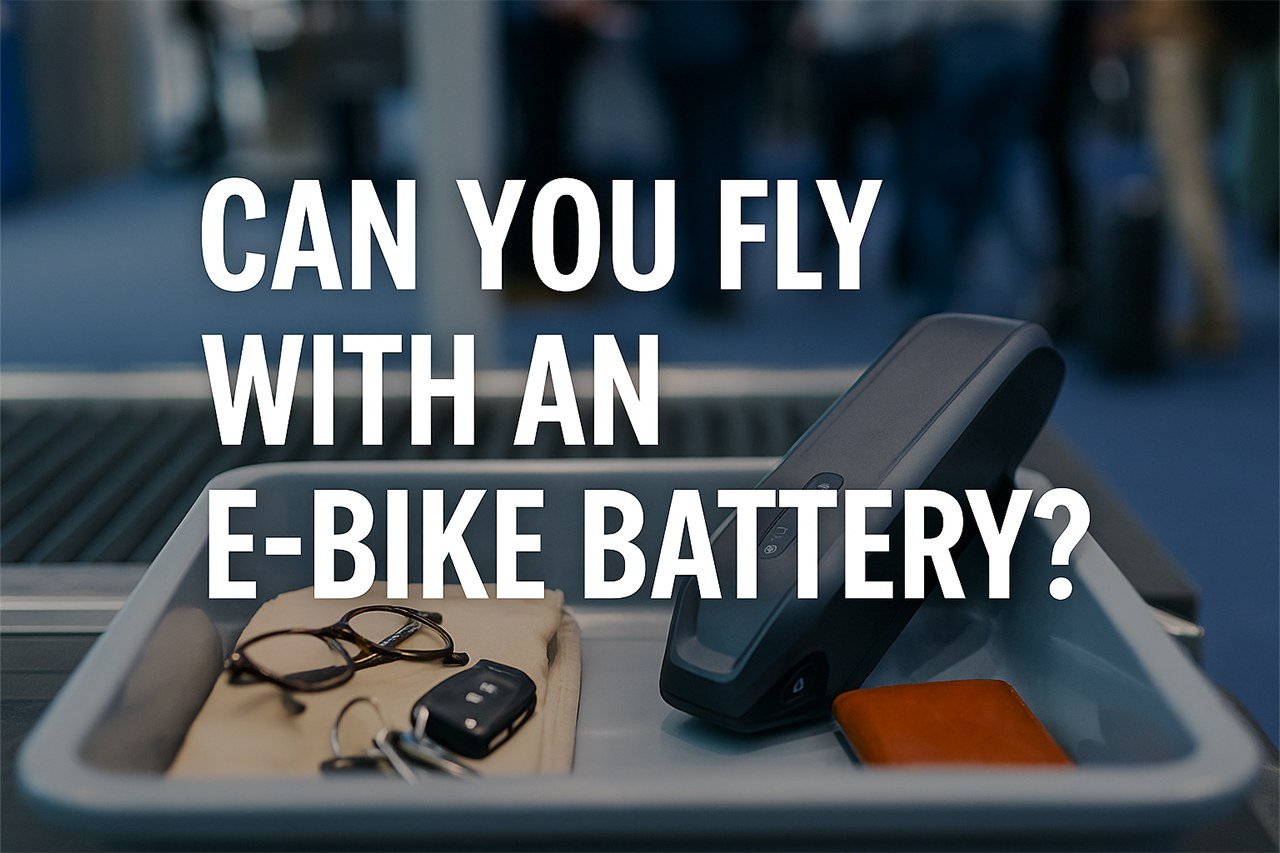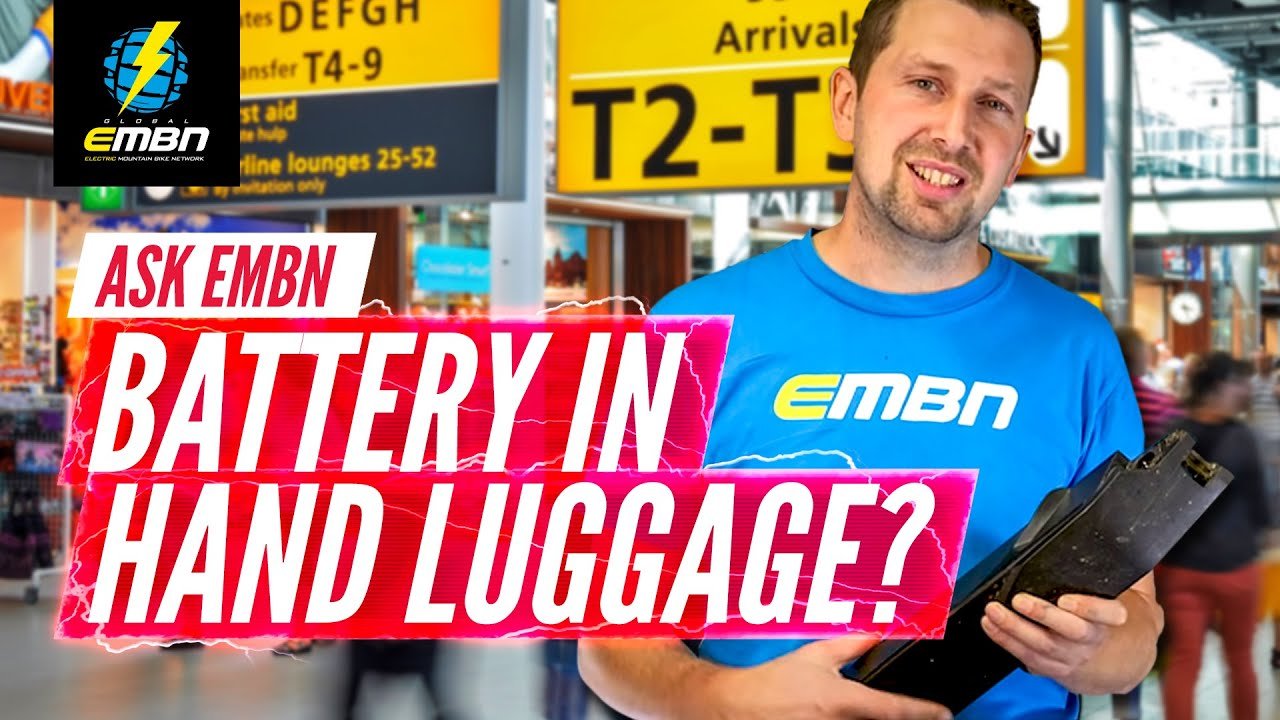
Traveling with an electric bike sounds exciting until the question pops up—can you actually take that e-bike battery on a plane? Many people planning cycling trips abroad run into this issue, and it’s not always clear what’s allowed. The rules can feel confusing, especially when every airline seems to have its own policy.
Most airlines do not allow e-bike batteries on passenger flights because lithium-ion batteries over a certain size are considered a fire risk. However, you can often remove the battery and ship it separately, or use approved travel-sized batteries that meet airline safety limits, as explained in guides like this one on flying with an electric bike.
This article explains how airline regulations work, how to prepare your bike and battery for air travel, and what alternatives exist if your battery can’t fly. It also covers how to contact airlines and navigate their policies so your trip goes smoothly from check-in to touchdown.
Can You Fly With an E-Bike Battery?
Airlines treat electric bikes differently from regular bicycles because of their lithium-ion batteries. These batteries can pose safety risks during flights, so travelers must plan ahead if they want to bring their e-bike or its battery on a plane.
Why Lithium-Ion Batteries Are Restricted
Lithium-ion batteries store a large amount of energy in a small space. If damaged, short-circuited, or exposed to heat, they can overheat or catch fire. For this reason, aviation authorities classify them as hazardous materials.
Most e-bike batteries exceed the 100-watt-hour (Wh) limit allowed in carry-on luggage. Even smaller batteries between 100Wh and 160Wh usually need airline approval. Anything above that is banned from both carry-on and checked baggage.
A quick comparison helps explain why:
| Battery Type | Typical Watt-Hours | Allowed on Plane | Notes |
|---|---|---|---|
| Laptop Battery | 50–100Wh | Yes (carry-on) | Commonly accepted |
| E-Bike Battery | 300–700Wh | No | Must be shipped separately |
| Power Bank | <160Wh | Sometimes | Airline approval needed |
Travelers can still transport their e-bike battery, but not by air. Many riders ship it ahead using ground services like UPS or FedEx, which follow strict packaging and labeling rules for lithium batteries. The Electric Bike Report explains that this method is the safest and most compliant way to move high-capacity batteries.
Differences Between E-Bikes and Regular Bikes
Regular bikes are simple to fly with. Airlines usually treat them as oversized luggage, and travelers only need to deflate the tires, turn the handlebars, and box them up.
E-bikes, however, are heavier and contain electronic components that make them more complex to pack. The biggest issue isn’t the bike frame—it’s the battery. Airlines view the battery as a fire hazard, not the bike itself.
Some airlines allow you to check an e-bike frame without the battery. Riders often remove the battery and ship it separately. According to BikeRadar, this approach makes it possible to fly with your e-bike to your destination and reunite it with its battery later.
Flying With an E-Bike Versus Just the Battery
Flying with a complete e-bike is tricky but doable if the battery is removed. Most airlines ban electric bikes with batteries installed, but they often accept the bike frame when packed properly. The battery must travel by ground or be rented at the destination.
When flying with just the battery, the answer is almost always no. Airlines prohibit large lithium-ion batteries in both checked and carry-on luggage. Even disassembled battery packs are not permitted because of the fire risk.
Here are some practical options:
- Ship the battery using a certified ground carrier.
- Rent a battery at your destination if compatible with your model.
- Buy a spare locally and leave it behind when returning home.
These steps allow travelers to enjoy their e-bike abroad without breaking airline safety rules.
Airline Regulations and Restrictions
E-bike batteries face strict travel rules because they contain lithium, which can pose fire risks at high altitudes. Airlines and government agencies limit their transport to protect passengers and crew from potential hazards.
Airline Policies on E-Bike Batteries
Most airlines ban fully assembled e-bikes from being checked or carried on board. The main issue is the lithium-ion battery, which often exceeds the airline’s watt-hour (Wh) limit. Many carriers only allow batteries under 100 Wh, while some may permit up to 160 Wh with prior approval.
Travelers can check their airline’s website or contact customer service before booking. Each carrier sets its own policy, and even small differences can affect whether the battery can fly.
A few airlines allow passengers to remove and ship the battery separately using certified hazardous goods couriers. This option helps riders avoid confiscation or denied boarding. For a detailed overview of how to navigate these restrictions, BikeRadar explains how most airlines ban electric bikes and what travelers can do to stay compliant.
Quick Reference Table:
| Airline Type | Typical Battery Limit | Battery Allowed in Cabin? | Notes |
|---|---|---|---|
| Major U.S. Airlines | 100–160 Wh | Sometimes | Must be removed and protected from short-circuit |
| Budget Airlines | 100 Wh or less | Rarely | Often stricter enforcement |
| International Carriers | Varies | Case-by-case | Check local aviation authority rules |
Federal Aviation Administration Battery Rules
The Federal Aviation Administration (FAA) sets nationwide standards for lithium batteries on U.S. flights. The FAA allows passengers to carry small rechargeable batteries under 100 Wh in carry-on bags. Batteries between 100–160 Wh need airline approval and are limited to two per person.
Checked luggage cannot contain spare lithium batteries. The FAA requires terminals to be covered or packed to prevent short-circuiting. These steps reduce the risk of overheating or fire during flight.
The FAA’s official battery guidance outlines what types are allowed and how to pack them safely. Following these rules keeps travelers compliant and ensures the flight crew can manage any incidents effectively.
International Versus Domestic Flight Differences
Domestic flights within the U.S. follow FAA regulations, but international routes add another layer of complexity. Each country’s aviation authority—such as EASA in Europe or CASA in Australia—sets its own restrictions on e-bike batteries.
Some countries prohibit any lithium batteries over 100 Wh, even with airline permission. Others require advance documentation or proof of compliance with UN38.3 testing, which certifies battery safety for air transport.
When flying internationally, travelers should:
- Contact both airlines if they have connecting flights.
- Check import rules for lithium batteries at their destination.
- Plan alternatives, such as renting an e-bike or shipping the battery separately.
These differences make planning ahead essential. A small oversight can mean leaving the battery behind or facing delays at security.
Preparing Your E-Bike and Battery for Air Travel

Flying with an e-bike takes careful prep. Airlines have strict rules about lithium batteries, and packing the bike itself can be tricky. Paying attention to battery removal, secure packaging, and proper documentation helps avoid delays or confiscation at the airport.
Battery Removal and Packing Tips
Most airlines restrict large lithium-ion batteries because of fire risk. E-bike batteries over 100Wh usually can’t fly in checked or carry-on luggage. Travelers often ship them separately or rent one at their destination.
Before traveling, remove the battery completely. Wrap the terminals in non-conductive tape to prevent short circuits. Use a fire-resistant bag or padded case for extra safety.
Quick battery prep checklist:
- Disconnect and remove the battery carefully.
- Cover terminals with tape.
- Store in a fireproof bag or approved container.
- Check watt-hour rating on the label.
- Confirm airline rules before packing.
For more details on airline restrictions and packing methods, see tips for flying with an electric bike.
Disassembling and Packing Your E-Bike
Disassemble the e-bike to fit airline size limits. Remove pedals, handlebars, and wheels. Wrap each part in bubble wrap or foam to prevent scratches.
A sturdy bike box or hard-shell case works best. Use padding between the frame and components to stop movement during transit. Label fragile parts clearly.
Packing basics:
| Step | Action | Purpose |
|---|---|---|
| 1 | Remove pedals and handlebars | Reduces size |
| 2 | Deflate tires slightly | Prevents pressure damage |
| 3 | Wrap frame and parts | Protects from scratches |
| 4 | Secure parts inside box | Prevents shifting |
Weigh the packed box to ensure it meets airline limits, usually around 50 lbs (23 kg).
Documentation and Labeling Requirements
Airlines may ask for proof that the battery meets UN38.3 safety standards. Bring the battery’s specification sheet or manufacturer’s documentation. This confirms compliance with transport regulations.
Label all boxes with your name, contact info, and destination address. Mark packages containing batteries with a “Lithium Battery—Handle with Care” label if shipping separately.
Keep receipts, manuals, and airline correspondence in one folder. Having documents ready helps speed up check-in and avoids confusion at security.
If unsure, contact the airline’s dangerous goods department a few days before departure to confirm what’s allowed.
Alternative Solutions for Traveling With E-Bike Batteries

Airline restrictions make it tough to bring large lithium-ion e-bike batteries on flights. Travelers often choose between shipping their batteries ahead or renting one after arrival to stay within airline safety rules and still enjoy their rides.
Shipping E-Bike Batteries Separately
Shipping a lithium-ion battery separately can be a practical choice, but it takes planning. Most carriers treat e-bike batteries as hazardous materials, so only certified shippers can handle them.
Before shipping, riders should:
- Check carrier rules for watt-hour limits and packaging standards.
- Use a UN-approved box with proper labeling.
- Disconnect and insulate terminals to prevent short circuits.
Some services specialize in moving e-bike batteries internationally. They often manage customs paperwork and safety documentation. However, costs can vary depending on the destination and the size of the battery.
| Factor | Why It Matters |
|---|---|
| Battery size (Wh) | Larger batteries face stricter shipping limits. |
| Carrier policy | Not all couriers accept lithium-ion batteries. |
| Destination country | Some have import restrictions on hazardous goods. |
For detailed airline guidance and travel tips, see this guide on flying with an e-bike.
Renting or Buying Batteries at Your Destination
Renting or buying a battery at the destination can save time and stress. Many bike shops and tour companies offer compatible e-bike batteries for rent, especially in cycling-friendly cities.
This option works best when the e-bike model uses a common battery system like Bosch or Shimano. Travelers should confirm compatibility before booking.
Buying a new battery locally can be more expensive, but it avoids shipping delays or airline rejections. It’s a good backup plan for longer trips or frequent travelers.
Pros of renting or buying locally:
- No airline or customs issues.
- Immediate access to a working battery.
- Opportunity to test newer or higher-capacity models.
Cons:
- Availability may be limited in smaller towns.
- Rental or purchase costs can add up for long stays.
Both methods let riders travel freely while respecting airline safety rules and protecting their e-bike investment.
Contacting Airlines and Navigating Policies

Airlines treat e-bike batteries differently depending on their size, watt-hour rating, and whether they’re attached or removable. Travelers who plan ahead, ask the right questions, and check official airline rules avoid most last-minute problems at the airport.
How to Find Airline E-Bike Policies
Most airlines publish their e-bike and lithium battery rules in the dangerous goods or special baggage section of their websites. Searching for “lithium battery restrictions” or “mobility device battery policy” usually brings up the right page.
If the airline doesn’t mention e-bikes specifically, look under the section for electric scooters or personal mobility devices. These often follow similar watt-hour limits.
A good starting point is this guide on airline e-bike rules, which explains how most carriers restrict or ban large lithium batteries. Always verify details directly with the airline before packing.
Quick tips for checking policies:
- Confirm the maximum watt-hour (Wh) limit allowed in carry-on.
- Check if removable batteries can be shipped separately.
- See if written approval is required before the flight.
- Print or save the airline’s policy for reference at check-in.
Questions to Ask Before Booking
Before buying a ticket, travelers should contact the airline’s customer service or dangerous goods department. A short call or email can prevent major issues later.
Ask for written confirmation of what’s allowed. Some airlines approve small batteries under 100 Wh, while others only allow them for medical devices.
Here are key questions to ask:
- What is the maximum battery capacity allowed on board?
- Can the battery travel in checked luggage or only carry-on?
- Do I need pre-approval or special labeling?
- If the battery isn’t allowed, can I ship it separately?
Getting answers in writing helps if airport staff question the battery later. It also ensures the traveler complies with airline restrictions for e-bikes and avoids confiscation.
Major Airline Examples
Different airlines interpret international safety rules in their own way. Some allow only batteries under 100 Wh, while others may permit up to 160 Wh with approval.
| Airline | Battery Limit | Allowed in Checked Bag? | Notes |
|---|---|---|---|
| Delta Air Lines | Up to 160 Wh (with approval) | No | Must be in carry-on and terminals protected |
| Lufthansa | Up to 100 Wh | No | Approval needed for larger batteries |
| Qantas | Up to 160 Wh | No | Pre-approval required before travel |
| British Airways | Up to 100 Wh | No | Battery must be removed and carried separately |
These examples show how much variation exists. Even if one airline allows a certain battery, another may not.
Travelers should always double-check the latest airline policies a few days before departure. Rules can change without notice, and staff training may vary between airports.
Final Thoughts

Flying with an e-bike battery can feel like trying to bring a small power plant on a plane. Airlines and airport security take lithium batteries seriously because of fire risks. Most carriers ban e-bike batteries from checked or carry-on luggage, especially those over 100 watt hours.
If travelers still want to bring their e-bike, they have a few options. They can ship the battery separately or rent one at their destination. Some riders even remove the battery and pack the bike frame only. For guidance, check airline rules and TSA battery limits before booking.
Here’s a quick reference table to keep things simple:
| Battery Type | Allowed on Plane? | Notes |
|---|---|---|
| Under 100 Wh | ✅ Carry-on only | Must stay installed in a device |
| 100–160 Wh | ⚠️ Airline approval needed | Usually limited to 2 spares |
| Over 160 Wh | ❌ Not allowed | Must be shipped as cargo |
Travelers who plan ahead can avoid airport stress. Checking airline websites or reading guides like this one on flying with e-bikes helps them stay compliant and keep their trip on track.
In short, flying with an e-bike battery is possible—but it takes planning, patience, and a bit of creativity.










